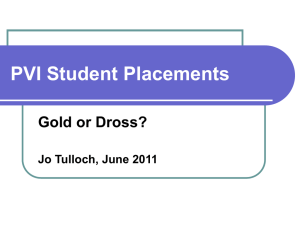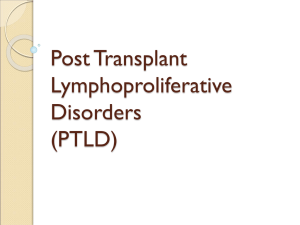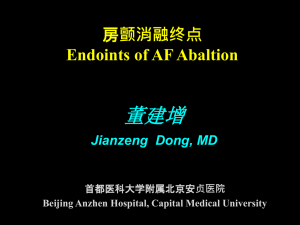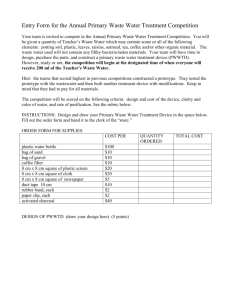Complications of transplantation Moderators: A.G. Jardine, Prof., D
advertisement
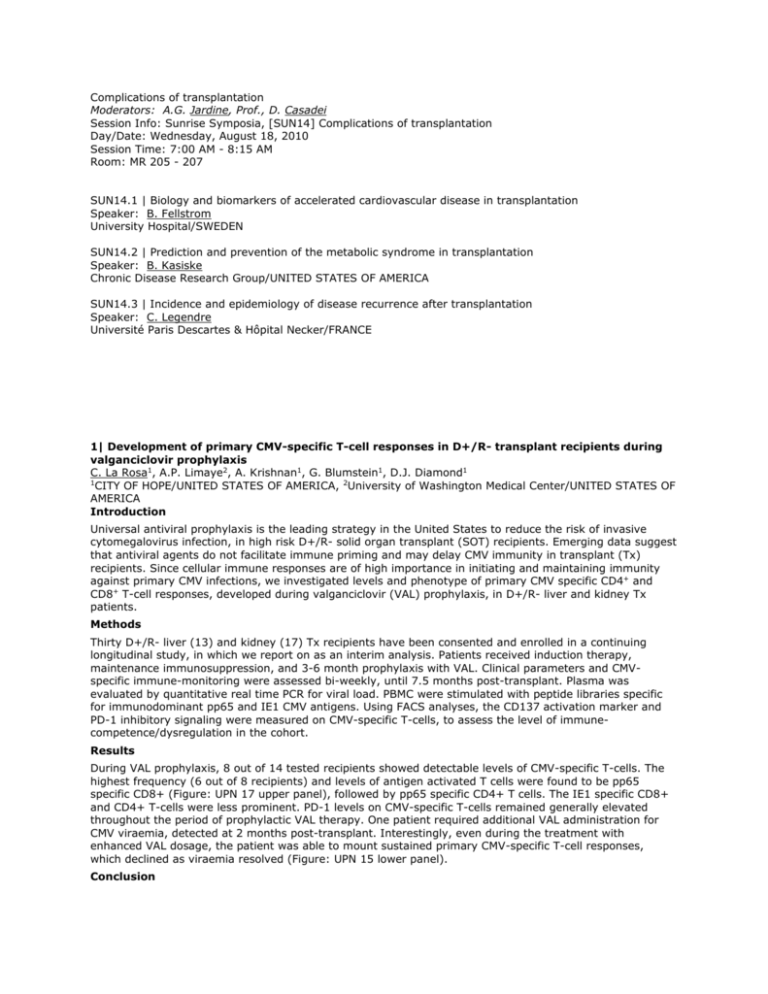
Complications of transplantation Moderators: A.G. Jardine, Prof., D. Casadei Session Info: Sunrise Symposia, [SUN14] Complications of transplantation Day/Date: Wednesday, August 18, 2010 Session Time: 7:00 AM - 8:15 AM Room: MR 205 - 207 SUN14.1 | Biology and biomarkers of accelerated cardiovascular disease in transplantation Speaker: B. Fellstrom University Hospital/SWEDEN SUN14.2 | Prediction and prevention of the metabolic syndrome in transplantation Speaker: B. Kasiske Chronic Disease Research Group/UNITED STATES OF AMERICA SUN14.3 | Incidence and epidemiology of disease recurrence after transplantation Speaker: C. Legendre Université Paris Descartes & Hôpital Necker/FRANCE 1| Development of primary CMV-specific T-cell responses in D+/R- transplant recipients during valganciclovir prophylaxis C. La Rosa1, A.P. Limaye2, A. Krishnan1, G. Blumstein1, D.J. Diamond1 1 CITY OF HOPE/UNITED STATES OF AMERICA, 2University of Washington Medical Center/UNITED STATES OF AMERICA Introduction Universal antiviral prophylaxis is the leading strategy in the United States to reduce the risk of invasive cytomegalovirus infection, in high risk D+/R- solid organ transplant (SOT) recipients. Emerging data suggest that antiviral agents do not facilitate immune priming and may delay CMV immunity in transplant (Tx) recipients. Since cellular immune responses are of high importance in initiating and maintaining immunity against primary CMV infections, we investigated levels and phenotype of primary CMV specific CD4+ and CD8+ T-cell responses, developed during valganciclovir (VAL) prophylaxis, in D+/R- liver and kidney Tx patients. Methods Thirty D+/R- liver (13) and kidney (17) Tx recipients have been consented and enrolled in a continuing longitudinal study, in which we report on as an interim analysis. Patients received induction therapy, maintenance immunosuppression, and 3-6 month prophylaxis with VAL. Clinical parameters and CMVspecific immune-monitoring were assessed bi-weekly, until 7.5 months post-transplant. Plasma was evaluated by quantitative real time PCR for viral load. PBMC were stimulated with peptide libraries specific for immunodominant pp65 and IE1 CMV antigens. Using FACS analyses, the CD137 activation marker and PD-1 inhibitory signaling were measured on CMV-specific T-cells, to assess the level of immunecompetence/dysregulation in the cohort. Results During VAL prophylaxis, 8 out of 14 tested recipients showed detectable levels of CMV-specific T-cells. The highest frequency (6 out of 8 recipients) and levels of antigen activated T cells were found to be pp65 specific CD8+ (Figure: UPN 17 upper panel), followed by pp65 specific CD4+ T cells. The IE1 specific CD8+ and CD4+ T-cells were less prominent. PD-1 levels on CMV-specific T-cells remained generally elevated throughout the period of prophylactic VAL therapy. One patient required additional VAL administration for CMV viraemia, detected at 2 months post-transplant. Interestingly, even during the treatment with enhanced VAL dosage, the patient was able to mount sustained primary CMV-specific T-cell responses, which declined as viraemia resolved (Figure: UPN 15 lower panel). Conclusion Antiviral agents have proved successful for prevention of CMV disease in high risk SOT recipients, though prophylaxis has been shown to interfere with immunity. The preliminary data from our study suggest that during VAL therapy CMV infection may occur in D+/R- transplant recipients, and a primary CMV-specific Tcell response can be promptly detected. However, PD-1 up-regulation measured on CMV-specific T-cells from this D+/R- cohort is indicative of a state of immune impairment, which may lead to uncontrolled viraemia or clinical symptoms, once the prophylaxis is suspended. Our ongoing longitudinal investigation focuses in characterizing cellular immunity dysfunction and its role in disease progression of D+ /Rrecipients during primary CMV infection. 2| The IMPACT Study: Phenotypic Analysis of Previously Uncharacterized Cytomegalovirus UL54 and UL97 Amino Acid Substitutions Detected in Virus from Patients Receiving 200 or 100 Days of Valganciclovir (Valcyte®) Prophylaxis S. Chou1, G. Marousek1, V. Wong1, G. Boivin2, N. Goyette2, M. Farhan3, R. Elston3 1 Portland VA Medical Center/UNITED STATES OF AMERICA, 2Centre Hospitalier Universataire de Quebec/CANADA, 3Roche products Limited/UNITED KINGDOM Introduction: IMPACT was a global phase III, randomized, double-blind, placebo-controlled study comparing 200 to 100 days of valganciclovir prophylaxis (900mg once daily) in 318 D+R- kidney transplant recipients. Previously we had reported that an equal number of patients (n=3/arm) had known ganciclovir resistance mutations in viral genes UL97 or UL54 detected during viral breakthrough. In addition, a large number of previously uncharacterized amino acid substitutions were observed, mostly in UL54. Recombinant phenotyping was performed to determine if these genotypic changes affected ganciclovir susceptibility, especially in those receiving the longer duration of prophylaxis. Methods: Sequence analysis of UL54 and UL97 was performed on virus obtained from patients meeting the resistance analysis criteria defined as: 1) Patients experiencing a positive viral load at the end of prophylaxis [Day 100 (both arms) or Day 200 (200 day arm only)] and/or 2) Patient experiencing CMV disease within 12 months of initiating prophylaxis and having a central laboratory confirmed positive (>600 copies/ml) viral load within 21 days of CMV disease. Recombinant phenotyping of individual amino acid substitutions was performed by mutagenesis of a recently constructed bacterial artificial chromosome clone of control laboratory strain T2211, followed by reporter-based yield reduction assay of the resulting live virus for ganciclovir susceptibility as previously described (Chou et al, Antimicrobial Agents Chemotherapy 2005; 49:2710-5). Results: Three patients in each treatment arm had a single known ganciclovir resistance mutation detected (200 Day UL97: C603W, M460V and UL54: P522S; 100 Day: UL97: M460V, C592G twice). Twenty seven individual uncharacterized amino acid substitutions were detected during the resistance analyses: 26/27 substitutions were observed once (200 Day: UL54 n=10; 100 Day: UL97 n=2; UL54 n=14); an additional substitution, UL54 E315D, was observed in three patients (200 Day: n=2; 100 Day: n=1). To determine whether these substitutions may confer reduced ganciclovir susceptibility, all 200 Day substitutions and eight 100 Day substitutions (prioritized based upon location and conservation) were selected for phenotyping . Results are available for 9/11 200 Day substitutions and 7/8 100 Day substitutions. Two amino acid changes (G698D and Y818C) were not evaluated due to poor viral growth and one 200 Day substitution remains under evaluation (S649P). No significant reduction in ganciclovir susceptibility was observed for any of the other substitutions. Conclusion: A similar, low number of patients (n=3) in both treatment arms had known ganciclovir resistance mutations detected. After phenotypic evaluation of previously uncharacterized amino acid substitutions within the 200 Day prophylaxis group, no increase in the incidence of ganciclovir resistance was detected when compared to those in the 100 Day prophylaxis group. 3| Limiting HCV Progression in Transplant Recipients Through Conversion to Sirolimus Based Immunosuppression G.J. McKenna1, J.F. Trotter2, E. Klintmalm1, S. Chinnakotla2, N. Onaca1, R. Ruiz2, M.F. Levy1, R. Goldstein1, G. Klintmalm2 1 Baylor Regional Transplant Institute/UNITED STATES OF AMERICA, 2Baylor University Medical Center/UNITED STATES OF AMERICA Introduction HCV causes progressive liver fibrosis in liver transplant (OLT) pts and is the main cause of allograft failure. Sirolimus (SRL) antifibrotic effects have been shown in animal models and we recently presented data in OLT pts showing that de novo SRL use limits fibrosis progression in liver allografts. However there are no reports on how conversion to SRL impacts established HCV fibrosis. We use the largest experience of SRL conversion patients to assess the impact of a conversion to SRL immunosuppression on HCV fibrosis after OLT. Methods We reviewed 1751 OLT pts from 1998 - 2009 identifying: a) Cohort of HCV+ pts converted to SRL after 1 year and; b) Control group of HCV+ pts never receiving SRL. Protocol bx were done at year 1 (pre-SRL) and year 2 (post-SRL) recording fibrosis stage (METAVIR score 04), and the change in fibrosis stage was compared between the cohort and control. ACR, HAT, CMV and survival were assessed. Results A total of 209 HCV+ pts (153 M, 56 F) were converted to SRL at a mean 2.8 yr (range 6 d-16.5 yr) with 16/209 pts converted to SRL at year 1 post OLTx and 13/16 pts (81%) having protocol bx at year 2. All 13 SRL pts (9 M, 4 F) were converted to SRL for CNI nephrotoxicity and none had SRL discontinued. Prior to SRL conversion there was no difference between the groups for either mean fibrosis or percentage of pts with advanced stage >=2. Change in Fibrosis Stage With Conversion to Sirolimus Conclusions Conversion to SRL limits fibrosis progression in HCV and can possibly reduce fibrosis stage in advanced disease. SRL conversion in HCV pts is safe, with no documented HAT, ACR, CMV infection and excellent post conversion survival. Conversion to SRL represents a potential novel therapy for OLT pts with recurrent HCV. 4-Pilot Study of Sirolimus/Leflunomide Therapy for BK Viremia L.A. Tibbles1, M. Maric Viskovic1, C.M. Rodriguez Velez2, A. Sar1, S. Yilmaz2 1 University of Calgary/CANADA, 2Alberta Health Services/CANADA Introduction: BK nephropathy has become the major leading cause of early renal transplant loss. Since the emergence of BK nephropathy occurred during an era of increased immunosuppression, current therapy consists of various methods of reduction of immunosuppression, but there are no randomized clinical trials to support this intervention. BK virus activates host intracellular signalling pathways to replicate its DNA and produce its protein coat, so we hypothesized that inhibition of these intracellular pathways would prevent viral replication and be an effective treatment for BK infection. We chose sirolimus as an mTOR inhibitor, and leflunomide as a tyrosine kinase inhibitor to interfere with BK pathogenesis. Methods: From November 2006 to the present all de novo transplant patients in the Southern Alberta Transplant Program (ALTRA) were screened monthly for BK DNA in urine by PCR. Positive urine BK PCR was followed by plasma BK PCR measurement. All patients positive for plasma BK by PCR at any level were treated with a combination of sirolimus (trough level 6-8 ng/ml) and leflunomide (trough level 40-100 micrograms/ml). Results: 17 patients have been followed for up to 3 years on this treatment regimen. There has been no increase in mean or median serum creatinine over this period of time. All patients have cleared BK virus from their blood (median time to clearance 78 days). 11 patients have been maintained on sirolimus/leflunomide for greater than one year. Discontinuation of treatment occurred for the following reasons: desire to conceive (1 patient), patient death (1 patient; stroke), side effects (1 patient), unrelated illness (2) and drug costs (1). Biopsies were performed at the first indication of BK viremia in all patients. Seven biopsies had no evidence of rejection. Four had borderline changes, and six had inflammation that fulfilled criteria for acute rejection (1 Type IA, 3 Type IB, 1 Type IIA and 1 Type III). Repeat biopsies were performed on 12 patients at one year of follow-up. Compared to the initial biopsy in the same patient, there were no significant differences in any of the Banff scores (g,t,i,v,ah,cg,ct,ci,cv, or the combined score cicvi) showing no increase in fibrosis over this period of time. Cylex ImmuKnow assay measurement of overall immunosuppression demonstrated no difference between 4 random sirolimus/leflunomide treated patients and 4 random patients without BK viremia treated with protocol tacrolimus and mycophenolate. Conclusions: Kinase inhibition with sirolimus and leflunomide is an effective treatment for BK viremia, which maintains renal function and preserves renal histology without the development of fibrosis over one year, potentially without decreasing immunosuppression. This therapy is currently being compared to reduction of immunosuppression in a multicentre randomized clinical trial (The BK:KIDNI Trial: BK viremia: Kinase Inhibition to Decrease Nephropathy Intervention Trial; ISRCTN40228609). 5| Multivariate Analysis of Risk Factors for Polyoma Virus Infection after Kidney Transplantation R. Singh1, T.B. Dunn2, R. Kandaswamy1, R. Fairchild1, K.J. Gillingham1, W.D. Payne1, T.L. Pruett1, D.E. Sutherland1, A.J. Matas1, E.B. Finger1 1 University of Minnesota/UNITED STATES OF AMERICA, 2Univ of Minnesota/UNITED STATES OF AMERICA Purpose: Identifying the risk factors (RF) for developing polyoma virus infection (PVI) after kidney transplantation. Methods: Retrospective analysis of consecutive adult kidney transplant recipients (KTRs) in a single center using binary logistic regression analysis. PVI was diagnosed as BK viremia detected by polymerase chain reaction, or by histopathological evidence of BK viral infection confirmed by SV 40 staining. Results: Total of 1498 KTRs during the period from 01/2000 to 02/2009 were studied. Minimum period of follow-up was 1 year (range 1-10 yrs). PVI was seen in 53 (3.5%) KTRs and seen after a mean period of 15 months post-transplant. KTRs with PVI had significantly poor actuarial graft survival (67% for PVI vs. 86% for No PVI, p=0.008, log rank test) but no difference was seen in patient survival (93% for PVI vs. 90% for No PVI cohort, p=NS, log rank test) after 5 years post-transplant. Univariate analysis showed that PVI was significantly associated with multiple acute rejection (AR) episodes (16% vs. 3%, p=0.0001), treatment of ARs (21% vs. 10%, p=0.03) with antibodies (thymoglobulin or OKT3) and male KTR (4% vs. 1.6%, p=0.01). There was no association of PVI with single acute rejection (27% vs. 22%), treatment of rejections with steroids alone, treatment of humoral rejections, use of tacrolimus/mycophenolate mofetil combination, use of thymoglobulin induction, recipient age or expanded criteria donor kidneys. The use of rapamycin showed a trend of negative association (5% vs. 12%, p=0.1) with development of PVI. Both CMV (34% vs. 25%) and BK (43% vs. 25%, both p<0.01) were significantly associated with AR episode, but the development of CMV infection did not predispose to development of PVI. Multivariate analysis showed multiple episodes of AR (p=0.009, Odds Ratio 4.1, CI 1.4-11.9) and male KTRs (p=0.008, OR 2.7, CI 1.2-5.7) to be the most significant RFs for developing PVI, whereas the use of antibodies for treating ARs lost significance. Subgroup analysis showed that PVI was significantly associated with cellular (43% vs. 24%, p=0.004), but not with humoral rejection (11% vs. 8%). PVI was associated with early (within 1st year) rejections (34% vs. 20%, both p<0.01). PVI associated with AR was seen to occur slightly earlier in the post-transplant period compared to PVI without AR episode (17 vs. 27 months). PVI was seen to occur after a mean of 6.6 months (SD 10.8) after the treatment of AR episodes. Conclusion: Polyoma viral infection is associated with poorer graft survival. It has a significant association with multiple episodes of acute rejection. The associations were stronger with cellular and early post-transplant rejection episodes. It is unclear whether multiple acute rejections are a risk factor on their own accord, or whether the treatment of multiple ARs with various immunosuppressive agents generates a milieu conducive for developing PVI. Male recipient gender is a RF for developing PVI which maybe explained due to hormonal factors. 6-| Risk Stratified Sequential Treatment with Rituximab and CHOP Chemotherapy in B-Cell PTLD Defining a New Standard of Care: Results From a Prospective International Multicenter Trial R.U. Trappe1, S. Choquet2, V. Leblond2, D. Dierickx3, P. Mollee4, J.M. Zaucha5, M. Sender6, T. Ekman6, P. Reinke1, R. Neuhaus1, H. Lehmkuhl7, M.H. Dreyling8, U. Dührsen9, G. Salles10, F. Morschhauser11, A. Jaccard12, T. Lamy13, I. Anagnostopoulos1, M. Raphael14, H. Riess1 1 Charité-Universitätsmedizin Berlin/GERMANY, 2Hôpital Pitié-Salpêtrière/FRANCE, 3University Hospital Gasthuisberg Leuven/BELGIUM, 4Princess Alexandra Hospital/AUSTRALIA, 5Medical University of Gdansk and Polish Lymphoma Research Group/POLAND, 6Sahlgrens Hospital/SWEDEN, 7German Heart Institute Berlin/GERMANY, 8University of Munich-Campus Großhadern/GERMANY, 9University Hospital, University of Duisburg-Essen/GERMANY, 10Centre Hospitalier Lyon-Sud/FRANCE, 11Centre Hospitalier Universitaire/FRANCE, 12University Hospital/FRANCE, 13CHU Rennes/FRANCE, 14Hospital Bicetre/FRANCE This trial aimed to investigate the efficacy and safety of sequential treatment with rituximab and CHOP-21 in patients with PTLD. An ongoing prospective, multicenter, international phase II trial was initiated in January 2003. Until 2007 patients were treated with a fixed sequence of rituximab at days 1, 8, 15, 22 followed by four cycles of CHOP-21+G-CSF starting 4 weeks after the last dose of rituximab (sequential treatment, ST). In January 2007 risk stratification according to the response to rituximab was introduced (risk stratified sequential treatment, RSST). In RSST patients achieving a complete remission after 4 courses of rituximab (low risk) continue with four 3-weekly courses of rituximab monotherapy while patients in PR, SD or PD (high risk) go on with R-CHOP-21+G-CSF. This is a scheduled interim analysis after inclusion of 104 patients. The median follow up is 34.0 months for ST (64 patients) and 9.1 months for RSST (40 patients). 61 ST and 35 RSST patients were diagnosed with monomorphic PTLD, 3/5 with polymorphic PTLD. PTLD usually was late PTLD (75%/75%) in an advanced stage of disease (Ann Arbor III/IV: 59%/58%). 49%/47% of tumors were EBV positive. The most frequent transplant types were kidney, liver and heart. With ST the overall response rate (ORR) was 89%. The complete remission (CR) rate was 69%. 86%, 75% and 75% of patients were without disease progression at one, two and three years of follow up (Fig. 1a). There were 6 early treatment related deaths (9%) resulting from infections and 2/64 patients died from refractory PTLD. With RSST the ORR was 90% and 73% achieved a CR. 90% of patients were without disease progression at one year (Fig. 1a). There was one early treatment related death due to infection (2.5%). 2/40 patients died from refractory PTLD. With similar relapse rates (1/16) subsequent consolidation with rituximab monotherapy (RSST) seems not to be inferior to consolidation with CHOP (ST) in low-risk patients, while high-risk patients seem to benefit from the treatment escalation from CHOP to R-CHOP (Fig. 1b). This is the largest prospective trial in PTLD so far. Sequential treatment with rituximab and CHOP-21+G-CSF is well tolerated and highly effective with a treatment related mortality rate of less than 10%. In comparison to historic series of rituximab monotherapy, significantly more patients achieve a CR and time to progression is very much prolonged. In comparison to historic series of CHOP, sequential treatment is much better tolerated. Introduction of risk stratification seems to improve these results further restricting chemotherapy related toxicity to high-risk patients without increasing the risk for relapse in low-risk patients. 7-O38.02 | IL-6 and TNF alpha plasma levels but not IL-10 plasma levels correlate with response to treatment in patients with PTLD: a longitudinal analysis form the German PTLD registry D 2006-2012 C. Hinrichs1, S. Wendland2, D. Eurich1, R. Neuhaus1, P. Schlattmann1, B. Gärtner3, I. Anagnostopoulos1, H. Riess1, P. Reinke1, R.U. Trappe4 1 Charité-Universitätsmedizin Berlin/GERMANY, 2Charité-Universitätsmedizin Berlin, CCV/GERMANY, 3University Homburg/Saar/GERMANY, 4Charite-Universitaetsmedizin Berlin/GERMANY Post-transplantation lymphoproliferative disorder (PTLD) represents one of the most frequent malignancies after solid organ transplantation. Although certain risk factors are well known, especially longitudinal studies on the impact of pro- and anti-inflammatory cytokines on tumor growth are missing. Based upon earlier studies promoting IL-6 and IL-10 as tumor markers, we evaluated the diagnostic and predictive properties of IL-6, IL-10 and TNFa in patients undergoing PTLD treatment. IL-6, IL-10 and TNFa plasma levels at diagnosis of PTLD in 38 patients were compared to cytokine plasma levels of 42 transplant controls selected by a computer based matching process and changes in IL-6, IL-10 and TNFa levels over time were calculated from a total of 266 single measurements over a period of >1 year using linear mixed models with random and fixed effects. 29/38 patients responded to treatment of PTLD while 9 patients had progressive disease. There were no stable disease patients. Baseline characteristics’ of patients and controls were comparable. Patients with PTLD had significantly elevated IL-6 and TNFa levels at diagnosis of PTLD, but there were no significant differences in baseline IL-10 levels (figure 1). The positive predictive value of IL-6 levels was 48.9%. Its negative predictive value was 92.0%. IL-6 levels significantly decreased over time in responders, while non-responders had increasing levels (figure 2a, p=0.0013). No significant changes of IL-10 levels were observed over time. TNFa levels stayed low in responders, but non-responders showed significantly increasing TNFa levels (figure 2b, p=0.0002). Neither EBV-association by histology nor the presence of EBV DNA loads in peripheral blood did impact on the faith of IL-6, IL-10 and TNFa plasma levels over time. In conclusion, IL-6, but not IL-10, plasma levels significantly correlate with tumor mass in PTLD independent of the patients and the tumors EBV status. With a negative predictive value of 92% it can be used for diagnosis of PTLD as well as in follow up. Because considerable TNFa elevation was observed with PTLD progression but not at a low/moderate tumor mass, it seems to correlate with inflammation seen in advanced malignancies, rather than with the tumor itself. Left: IL-6 levels significantly decrease over time in patients responding to treatment (open circles). Nonresponding patients (filled cricles) show increasing levels (p=0.0013). Right: TNFa levels stay low in responders, but non-responders show significantly increasing TNFa levels (p=0.0002). 8-O38.06 | Immunosoppressive therapy and risk of post-transplant malignancies in renal transplants: Italian multicentric study. G. Segoloni1, P. Rigotti2, S. Sandrini3, G. Busnach4, S. Stefoni5, D. Donati6, F. Citterio7, G. Piredda8, P.G. Messa9, P. Veroux10, P. Piselli11, D. Serraino12 1 S. Giovanni Battista Hospital - Le Molinette/ITALY, 2University of Padua/ITALY, 3Spedali Civili of Brescia/ITALY, 4 Niguarda Ca' Granda Hospital/ITALY, 5S.Orsola Hospital University of Bologna/ITALY, 6Azienda Ospedaliera Ospedale di Circolo– Fondazione Macchi/ITALY, 7Catholic University/ITALY, 8Azienda Ospedaliera G. Brotzu/ITALY, 9 Fondazione IRCCS Ca' Granda- Ospedale Maggiore Policlinico/ITALY, 10University Hospital of Catania/ITALY, 11 National Institute for Infectious Diseases L. Spallanzani IRCCS/ITALY, 12IRCCS Centro di Riferimento Oncologico (CRO), Aviano (PN)/ITALY Objective: Quantify incidence rate (IR) and excess risk of tumors (except non-melanoma skin cancers) after kidney transplantation (KT) in Italy and investigate role of immunosuppression (IS) comparing Calcineurin (CIn) and Proligeration Signal Inhibitors (PSi). Methods: A longitudinal study was conducted on 4258 KT pts (65.2% males) from 10 Italian centers (. Period at risk of cancer (person-years, PY) was computed from KT to date of cancer, death or last follow-up. Observed incidence was compared with Italian Cancer Registries data through sex- and age-standardized IR (SIR and 95% confidence intervals, CI). Incidence rate ratio (IRR) were computed to identify risk factors associated with all or specific cancer development after adjustment for gender, age, calendar years of KT, years of follow-up, donor status, immunosuppressive protocol and induction therapy with antibodies,. RESULTS: In 22985 PYs (median 5.1 yrs), 208 pts (4.9%) developed a total of 216 cancers [42 Kaposi’s SarcomaKS, 23 Non Hodgkin Lymphoma-NHL, and 148 solid tumors including 27 Kidney, 21 Lung and 18 prostatic cancers]; overall incidence was 9.6 cases/1000 PYs with a 1.6 significantly increased SIR (95% CI: 1.4-1.9). Significant increases were found for KS (SIR=123), NHL (4.3), kidney (5.9) and utherine cancers (6.4) but not for all solid cancers (SIR=1.0), breast, lung, bladder, colon or prostatic cancers. Considering the risk factors for malignancies development, increased incidence for all cancers was associated, after adjustment, with male gender (IRR=1.4), older age (IRR=5.9 for >60 years of age vs <40 years), early follow-up (<2 years, IRR=1.4) and CIn alone (IRR=1.9 vs. CIn+PSi); significant risk factors for KS were older age, early post-KT period (<2 years, IRR=10) and no induction (IRR=2.6). A decreased incidence (close to significance) of KS was observed in pts treated with CIn+PSi (IRR=0.4 vs. CIn group, p=0.07). No KS cases were observed in PSi group. CONCLUSIONS: KT pts are at higher risk for especially virus-associated cancers, pointing out the importance of cancer surveillance after KT. Decreased incidence of all cancers and KS in pts treated with PSi and induction therapy, indicate a possible role of specific IS in cancer risk reduction.
